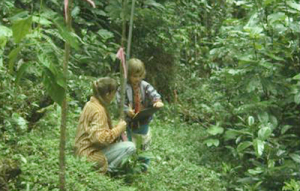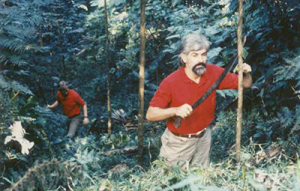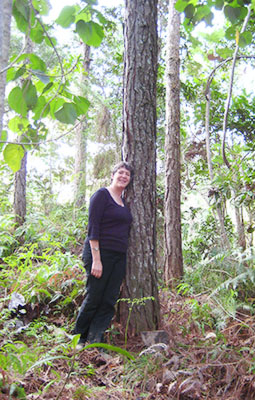History of line planting
In Puerto Rico enrichment planting could make a considerable contribution to the local island economy by replacing some imported wood with local production, providing income to landowners and employment in timber industries. Puerto Rico currently imports nearly all of its timber from the United States. Frank H. Wadsworth has estimated that at least 48% of this timber could be produced in Puerto Rico’s secondary forests without conflicting with agricultural land use, reducing the island’s net imports, and providing large increases in local employment. This would be particularly significant in rural undeveloped areas such as Patillas, where unemployment in some sectors is over 20% (LAUS, 2011). Enrichment line planting could support the local economy while protecting soils and maintaining biodiversity. PICO (1974) estimated that 25% of the island would need to remain forested to adequately protect the soils and watersheds.
Between 1984 and 1990 some forty thousand tree seedlings were planted in lines through the forest using hand-tools to minimize damage to existing soil structure. This process was carried out in about 25% of the secondary forest (87 ha) at Las Casas de la Selva. The steeper slopes of the forest were left untouched for fear of erosion and to provide areas to study natural succession of the forest. On the areas previously converted to grazing, Pinus caribaea (Caribbean pine) was planted to hold the soil and mahogany and mahoe interplanted once the pines had established.
The plantations were established considering topographic outlines, east-west orientation to maximize sun exposure and following criteria for erosion control. The line planting was at approximately 3 m (10 ft) spacing within the lines and 10 m (32.5 ft) spacing from line to line under a canopy of secondary forest. The initial planting density for mahogany was approximately 370 trees/ha (148 trees/ac) and for mahoe 415 trees/ha (166 tree/ac). It was anticipated that hurricanes, vine-overgrowth, natural die-off and landslides would significantly reduce the density of planting, perhaps reducing the density to one-third that of planting, even before thinning might be needed. During planting, large native trees of valuable timber species were left untouched with gaps in planting lines around them.
The trees have grown up rapidly with the combination of protection and competition afforded by the surrounding forest, and impact upon the ecology is minimal as careful monitoring and study has shown. This line planting technique provides a viable alternative to landowners making potentially irreversible decisions that may involve destroying rainforest lands forever along with devastation of watersheds from erosion and impacts on the carbon cycle.
In 2000, using the trees planted from 1984-1990, 22 0.4-ha plots were established using a random selection of plot locations from a map grid, including 19 plots of mahogany and three plots of mahoe, reflecting the greater use of mahogany in the original line-planting.
In 2003, five 0.4-ha plots of mixed broadleaf tree species were planted to evaluate the potential timber production using a wider range of species. The Department of Natural & Environmental Resources of Puerto Rico recommended the species and supplied the planting materials. The species included were “Capa prieto” or Spanish elm (Cordia alliodora (Ruiz & Pav.) Oken), “Moralon” or grandleaf seagrape (Coccoloba pubescens L.), “Santa Maria” or Antilles calophyllum (Calophyllum brasiliense Britton), Honduras mahogany (Swietenia macrophylla King), and “cédre espagnol” or Spanish cedar (Cedrela odorata L.) selected based on their potential ecological and economic value.
Since 2000, tree surveys have been underway to determine the survival and growth rate of the mahogany and mahoe. The enrichment project was designed to test the efficacy of line planting enrichment in the wet forest life zone as a dual means of providing both economic return and protection of natural biological resources. Nelson et al. found that vegetation and amphibian biodiversity were similar in areas of line-plantings and unplanted secondary forest at Las Casas de la Selva over 20 years after line planting. If valuable economic returns are achieved from line planting efforts, Las Casas de la Selva will provide a model for future sustainable forestry initiatives in secondary forest management.
Trees planted between 1983 and 1988
- Mahogany (Swietenia macrophylla x S. mahagoni): 22,400 on approx. 155 acres (63 hectares, 159 cuerdas)·
- Blue mahoe (Talipariti elatum, previously Hibiscus elatus): 3,600 on approx 23 acres (9 hectares, 23.70 cuerdas)
- Pine (Pinus caribaea): 5,000 on approx 10 acres (4 hectares, 10.29 cuerdas)
On approximately 40 acres (41 cuerdas, 16 hectares):
- Algarrobo (Hymenaea coubaril)
- Ausubo (Manilkara bidentata)
- Cacao (Theobroma cacao)
- Capa Blanco (Petitia domingensis)
- Capa Prieto (Cordia alliodora)
- Cedro (Cedrela odorata)
- Granadillo (Buchenavia capitata)·
- Maga (Thespesia grandiflora)
- Moca (Andira inermis)
- Eucalyptus (Eucalyptus robusta)
- Roble Blanco (Tabebuia heterophylla)
- Teak (Tectona grandis)
See more in-depth information about our forest.





